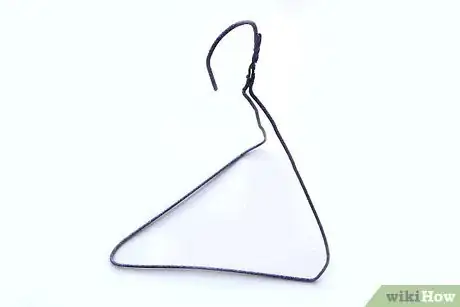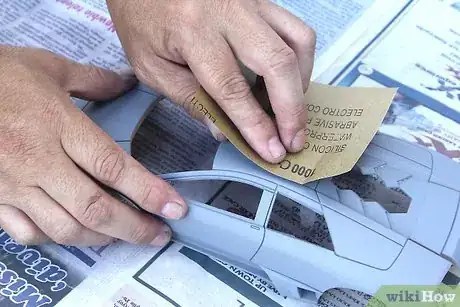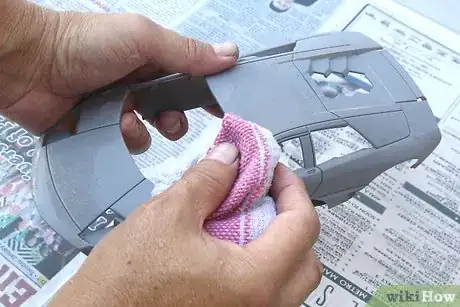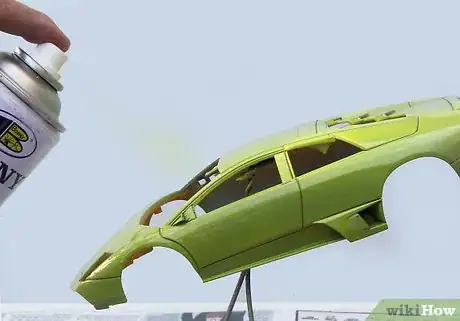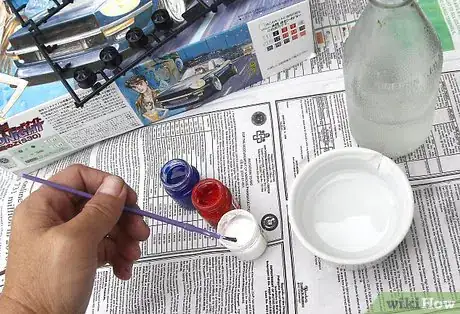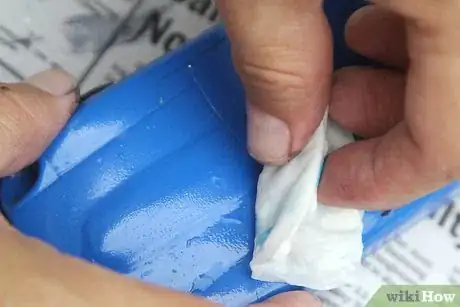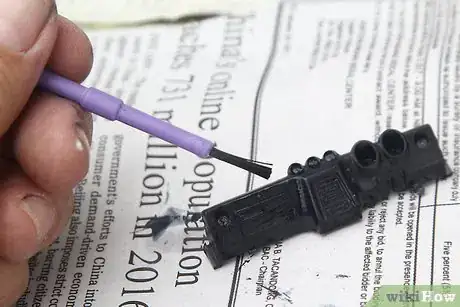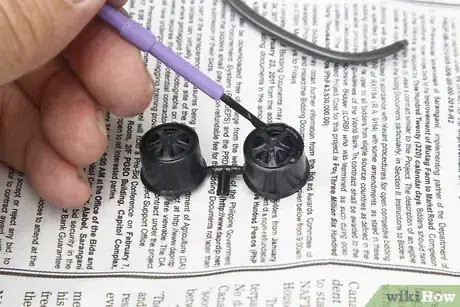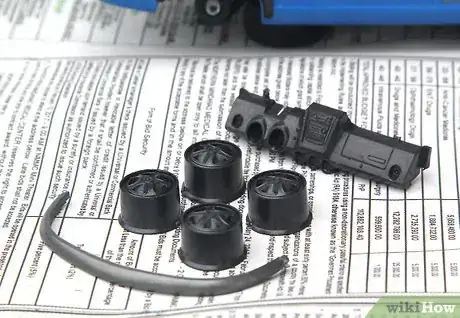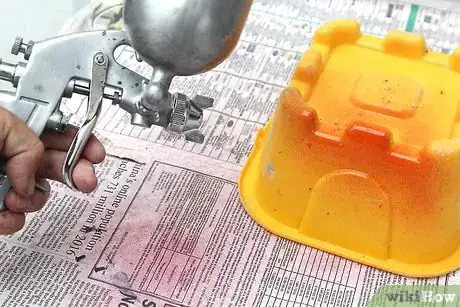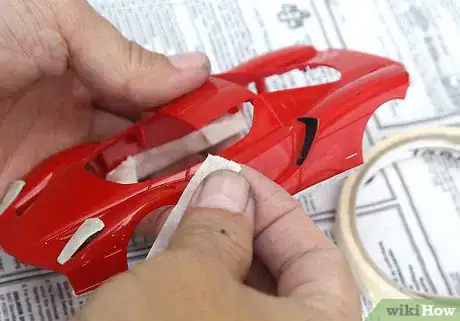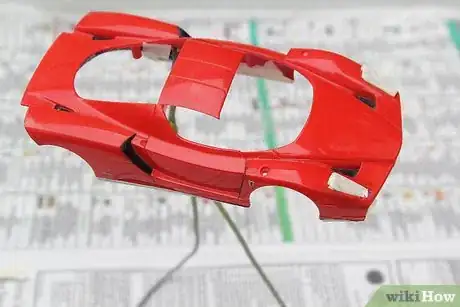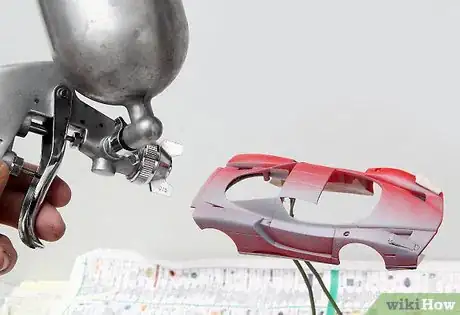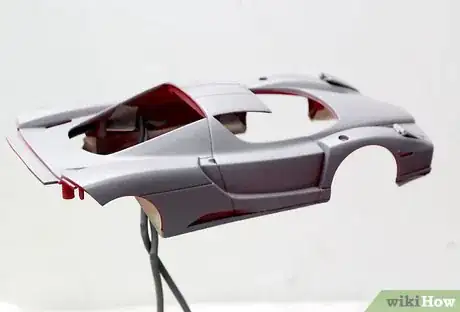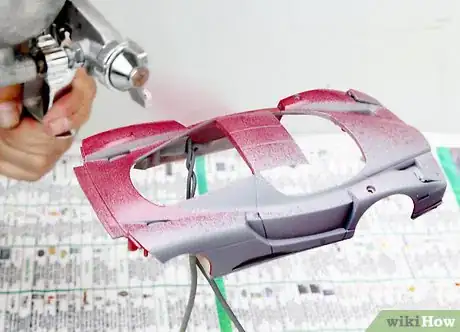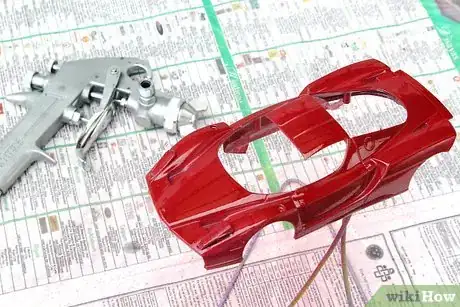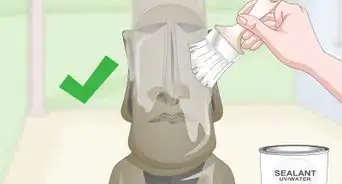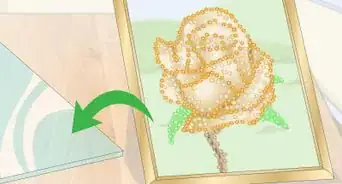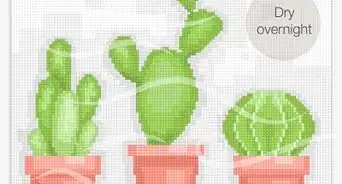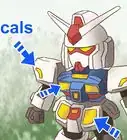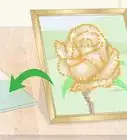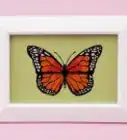This article was co-authored by wikiHow Staff. Our trained team of editors and researchers validate articles for accuracy and comprehensiveness. wikiHow's Content Management Team carefully monitors the work from our editorial staff to ensure that each article is backed by trusted research and meets our high quality standards.
There are 8 references cited in this article, which can be found at the bottom of the page.
wikiHow marks an article as reader-approved once it receives enough positive feedback. In this case, 92% of readers who voted found the article helpful, earning it our reader-approved status.
This article has been viewed 127,355 times.
Learn more...
Constructing model cars is a fun and engaging hobby that's great for people of all ages. When putting together your model car, it's important to pay attention to small details. For that reason, painting your car is almost as important as putting it together well. You can paint your model car in a variety of ways including using spray paint, using an airbrush, or painting it by hand. Whatever you decide, painting a model car enables you to use your creativity to create your own personalized model.
Steps
Spray Painting Your Model Car
-
1Attach your model to a wire coat hanger. Pull on the middle of a wire coat hanger so that it looks like a diamond. Continue to flatten out both sides so that they run vertically. Once your done doing that, bend the hanger over itself to create a stand that your car model can hang on while you work on it. The hanger should look like the letter C. Attach the end of the hanger to the inside of your model using a strong masking tape.[1]
- Once you're done taping your model to your stand, test its stability by pressing your fingers on the front and back of the model.
- Attaching your model to a hanger will allow you to spray paint the entirety of the car, including the bottom and interior.
-
2Spray a layer of protective primer over your car's model. Purchase a model-specific primer or a general primer to lay an opaque base coat for your model. You can purchase a protective primer at most arts and crafts stores. Apply pressure to the trigger of the primer and try to get an even coat across the surface and interior of the model. Once you're done, remove the tape and spray primer in the areas that were covered up by the tape. Keep your model in a well-aerated area while it dries. [2]
- If you are using a primer specifically made for model building, you don't need to apply a base primer, though it could add to the overall consistency of your paint job.
- Use a gray or off-white primer for your model car.
- Primer will also act as an adhesive for other layers of paint.
- A layer of primer is necessary if you want to use real automotive paint because it contains solvents that are harmful to the plastic model.
- The primer will take anywhere from two to four hours to dry.
Advertisement -
3Sand the model with a fine grit sandpaper. Take the model off of the stand and use a 1200-1500 sandpaper to smooth out the car's surfaces. When sanding, make sure not to sand off the protective primer that you applied. If you notice that you do, go back to the area and spot paint with your spray can. The goal is to get your model smooth and ready for painting.[3]
-
4Wash your car. Wash your car with a damp rag and a drop of mild dish soap. There will probably be primer residue left over from sanding that you should remove. If there is dust on the surface of your car before you paint it, it will be trapped in the paint job. Pat your car dry once you're done.
-
5Apply your coats of paint. Reattach the car to your painting stand and shake your spray paint can. Point the spray paint can on your car and administer pressure to the trigger while slowly sweeping the can horizontally to apply even coats of paint across the surface of your car. Once you're done, allow the paint to dry overnight before applying another coat of paint. Continue to do this until the color reaches the deepness and richness that you desire.[4]
- Before you paint your model, it's smart to practice using the spray can on a piece of newspaper.
- Spray can handles are add-on mechanisms that you can add to any can to make it easier to spray.
- Enamel paint dries slowly and hardens to a shiny finish.
- Acrylic paint dries quickly and is easier to clean up.[5]
-
6Sand and wash your car. Once you've painted your car to the desired hue, you'll most likely want to remove the bumps and imperfections in the dried paint. Sand the surface of your car with a very fine 3600 grit sandpaper. Once the surface of the car looks smooth and even, wash the car with cold water and a drop of mild dish soap.
Hand Painting the Car
-
1Add paint thinner and stir your paint. There are paint thinners that have been created specifically for model use. If you are using a specific brand of paint, use the same brand of paint thinner. If you can't find paint thinner or want to create your own, combine 50% distilled water with 50% of propyl alcohol and your paint in a 1:1 ratio. Thinning out the paint lightens the consistency and enables you to make more consistent coats.[6]
-
2Wash your model car. Use a mild dish soap and cold water with a rag to wash off your car. Remove any particles of dust that may have built up on the surface of the car as a result of sanding. Wipe the model dry before moving onto the next step.
-
3Paint the smaller pieces of your model first. Dip your brush into your paint and fill in the more intricate pieces of your model, like the mirrors first. Make sure not to paint over areas where your model will fit together, or you may have trouble assembling your model correctly.[7] Get a variety of different sized brushes to make painting easier.
- You can use either a synthetic or natural-haired brush to paint your car models.
-
4Apply paints using even, consistent strokes. Continue to paint over larger parts of the car. Do not dab or scrape with the brush unless you are doing specific detailing. Instead, you want to achieve an even coat by making long and even strokes.
- Popular paints for model cars include Testors, Model Masters, Humbrol, Tamiya, PollyScale, Floquil, and Vallejo.[8]
-
5Allow your model car parts to dry before applying additional coats. Allow your model car to dry overnight before going back to apply additional coats to the model. Continue to work at painting your car, applying the paint as evenly across the model as possible. Apply painter's tape to finished details so that you don't ruin them when applying additional coats of paint.
Air Brushing the Car
-
1Practice airbrushing on a separate piece of plastic. Read the user's manual for the airbrush that you are using. Once you've correctly hooked up your air brush, practice at different pressure levels to get a feeling for how the airbrush works. Use a cheap paint and airbrush on large pieces of butcher paper. Airbrushes typically cost anywhere from $25 to $300 and up.
- Remember to wear a protective mask and to lay out a tarp on your work area when using an airbrush.
-
2Wash your model car. Use a mild dish detergent and cold water to wash the surface of your car. This should remove molding agents which could react poorly with your paint. Once your car is free of dirt and dust, allow it to air dry before airbrushing it.
-
3Tape off special designs and decals. Because an airbrush paints a large area at a time, it's important that you tape off decals or designs that you want to paint in later. Once you've achieved the car has dried, you can remove the painter's tape and fill in finer details with a more precise tool like a brush.
-
4Set your model car on a wire hanger. In order to quickly airbrush your car, it will need to be suspended in the air. Use a bent wire hanger as a base and stand for your model car, attaching the stand to the car from the inside. As an alternative, you can also find a stable and flat pillar to set your car on top of as you paint. Make sure to attach the car to the stand using masking tape.[9]
-
5Use a gray or off-white primer for your model car.
-
6Allow primer to completely dry before proceeding to the next step.
-
7Apply an airbrushed coat of paint onto your car. Connect the paint jar color that you want to use to your airbrush. Apply the first base coat with your airbrush by applying pressure to the actuator, or button on the top of the airbrush. Quickly move your hand left to right and apply mist coats at 25-30 PSI. Continue to rotate your model car as you apply more coats of paint. When you are nearing the end, lower the PSI on your airbrush to 18-20 PSI to apply the final one or two coats.[10]
- Lowering the airbrush PSI will make the paint come out thicker.
- Do not let the thick paint run, or it may ruin your model. Be conservative on thick coats of paint.
- Remember to airbrush separate parts of your car, such as the hood, as you paint the car's body.
-
8Allow the paint to dry. Dry your car model for 24-48 hours before handling it. Keep the car in a cool area free of sunlight while it dries. Once it's totally dried, examine the car and look for areas that are not painted. Instead of airbrushing over the car again, fix small details with a brush and matching paint.
Community Q&A
-
QuestionHow do I paint chrome stripes?
 T. ChinsenTop AnswererFollow instructions of the paint manufacturer. Any metallic effect needs a good base layer. If the surface color is dark, any chrome color needs a suitable layer under for the chrome to shine. Check out model making websites and YouTube for details.
T. ChinsenTop AnswererFollow instructions of the paint manufacturer. Any metallic effect needs a good base layer. If the surface color is dark, any chrome color needs a suitable layer under for the chrome to shine. Check out model making websites and YouTube for details. -
QuestionBad paint job needs stripping, what's the best method?
 T. ChinsenTop AnswererTo remove your paint, find out what is its solvent base. Obtain that solvent to remove the paint. Ask the paint manufacturer if there is no information on the container. They can give you the best method to remove the paint as they know its properties. A base primer is usually needed to get paint to adhere evenly over most surfaces.
T. ChinsenTop AnswererTo remove your paint, find out what is its solvent base. Obtain that solvent to remove the paint. Ask the paint manufacturer if there is no information on the container. They can give you the best method to remove the paint as they know its properties. A base primer is usually needed to get paint to adhere evenly over most surfaces.
Things You'll Need
- A model car
- Sandpaper
- Paint
- Brushes
- Wire coat hanger or stand
- Air Brush
References
- ↑ http://www.finescale.com/online-extras/2002/11/using-automotive-paint-on-your-models
- ↑ http://www.scalemodelguide.com/painting-weathering/painting-guide/primers/#
- ↑ http://www.finescale.com/online-extras/2002/11/using-automotive-paint-on-your-models
- ↑ http://www.popularmechanics.com/home/outdoor-projects/how-to/a8912/10-tips-for-better-spray-painting-15474314/
- ↑ http://www.modelairplanebuilding.com/painting.html
- ↑ http://www.djmcadam.com/hand-painting-model-cars.html
- ↑ http://www.revell.de/contentpages/en/best-tips/index-en.html
- ↑ http://www.modelairplanebuilding.com/painting.html
- ↑ https://www.youtube.com/watch?v=ooU3PoUeEVo
About This Article
Painting your car is one of the most exciting parts of making a model. You can spray paint, hand paint, or airbrush your model car. If you’re using spray paint, remember to sand your car and apply a protective primer first to help the paint stick. If you’re hand-painting your model, mix your paint with paint thinner for more consistent coats and brush the paint on. To use an airbrush, first, apply a gray or off-white primer. Then, paint your car using 25-30 PSI once the primer has dried. Whichever method you use, paint the sections of your car individually before you put them together so you don’t accidentally paint parts you don't want to. After each coat, leave your car to dry overnight, and apply as many coats as you want until you’re happy with the color. For more tips, including how to prop up your model car while you paint it, read on!
